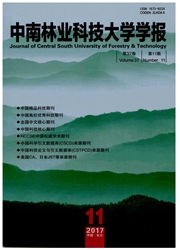

 中文摘要:
中文摘要:
为了探索山地森林水源涵养区与山前走廊水源消耗区降水和气温变化差异,2006年在祁连山北坡、河西走廊的南边缘、北边缘建立3套自动气象站,2015年提取3个气象站的2007~2014年的降水和气温共计19.3万组数据。采用特征参数算法、相关和多元回归分析方法,研究了降水和气温的年内年际变化特征及相关回归模型。结果表明:(1)从走廊北边缘到南边缘再到祁连山北坡,随着海拔的逐增,年均降水量逐渐增大,年均气温逐渐减小,但年际变化幅度相反,则降水量的变化幅度逐减,气温的变化幅度逐增。走廊北边缘和祁连山北坡年均气温呈波动性增加趋势,而走廊南边缘的年均气温呈波动性略有减少趋势;降水量均呈波动性减少趋势。(2)从走廊北边缘到南边缘再到祁连山北坡,随着海拔的逐渐增大,月降水量都逐渐增大,气温都逐渐减小;祁连山北坡月均降水变化幅度最小,月均气温变化幅度最大;走廊南、北边缘的月均降水和气温变化幅度基本接近,变化幅度都较小。(3)降水和气温属于高度相关或者显著性相关;祁连山北坡、走廊南边缘、北边缘降水和气温的回归模型都通过了R2拟合检验、F方差检验、t偏回归系数检验。通过模型评估和分析,降水量和气温回归模型的拟合效果都较好,可预测祁连山北坡、走廊南边缘、北边缘降水量和气温在97.6%以上,且准确率可达97.1%以上。本研究可为研究土壤、植被、水资源的垂直梯度变化提供参考数据,也可为进一步解决山区林牧与川区水资源短缺双重矛盾、山区防火风险指数与川区生态环境承载力矛盾提供科学依据。
 英文摘要:
英文摘要:
In order to explore variance of precipitation and air temperature change between mountains forest water conservation area and slope front corridor water consumption area, three sets of automatic meteorological station had been set up in 2006 in the north slope of Qilian mountain, the south and the north edge of the hexi corridor, and had extracted 193 000 groups of data about precipitation and air temperature from 2007 year to 2014 year. The algorithm of characteristic parameters, correlation and multiple regression analysis method had been used, and the characteristics of precipitation and air temperature interannual and annual variance and regression model had been studied. Results show that: (1)The average annual precipitation increased gradually, and the average annual air temperature decreases, but interannual amplitude was contrary, the precipitation variation diminishing return, change range of air temperature increase with altitude increases from the north corridor edges to the south to the north slope of Qilian mountains. The air temperature in north corridor edges and north slope of Qilian mountains showed a trend of volatility increase, but the air temperature in the north corridor edges showed a trend of volatility decrease, and the precipitation all showed a trend of volatility decrease. (2) The average monthly precipitation increased gradually, and the average monthly air temperature decreases with altitude increases from the north corridor edges to the south to the north slope of Qilian mountains. The rangeability of average monthly precipitation was minimum, but average monthly air temperature was maximum in north slope of Qilian mountains, but the rangeability of average monthly precipitation and air temperature was smaller in north corridor edges to the south.(3) The precipitation and air temperature were highly relevant or significant correlation. The regression model of precipitation and air temperature about the north corridor edges and south and the north slope of Qilian mounta
 同期刊论文项目
同期刊论文项目
 同项目期刊论文
同项目期刊论文
 期刊信息
期刊信息
